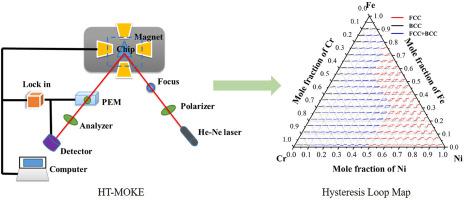Journal of Materiomics ( IF 8.4 ) Pub Date : 2022-08-27 , DOI: 10.1016/j.jmat.2022.07.006 Cai Chen , Xinyi Ji , Jianhao Wang , Mei Liu , Yao Lu , Xiaoping Wang , Aimin Zhang , Li Chen , Xianping Dong , Lanting Zhang , Hong Wang

|
Fe-X-Ni (X = Cr, W and V) combinatorial thin-film (∼100 nm thick) materials chips covering the full composition range of ternary systems were fabricated. The crystal structure distribution was mapped by micro-beam X-ray diffractometers (XRD) and the magnetic hysteresis loops over the chip were characterized by a high-throughput magneto-optical Kerr effect (HT-MOKE) system to establish the composition-phase-magnetic properties relationships. The results showed that saturation magnetization for all systems has a strong dependency on alloying composition, and decreases with increasing dopped elements content as a general trend. Although the trend of saturation magnetization in bulk is in good agreement with that from thin films, all bulk samples show almost no coercivity, attributable to the much smaller grain size, and stronger texture in thin-film samples. Comparing the Fe-X-Ni systems under a similar condition, in the out-of-plane, Cr alloying obtained the largest coercivity (∼400 mT) followed by W alloying (∼300 mT) and then V alloying (∼200 mT). We suggest that alloying with different elements leads to the diverse orientation and crystallinity of the fcc phase resulting in different magnetic properties. Meanwhile, the effect of heat treatment on magnetic properties indicates that saturation magnetization is more closely related to the duration of heat treatment.
中文翻译:

组合材料芯片法快速筛选多种 Fe-X-Ni 体系的磁性
Fe- X -Ni ( X = Cr,W 和 V)组合薄膜(~100 nm 厚)材料芯片涵盖了三元系统的全部组成范围。晶体结构分布由微束 X 射线衍射仪 (XRD) 绘制,芯片上的磁滞回线由高通量磁光克尔效应 (HT-MOKE) 系统表征,以建立成分-相-磁性关系。结果表明,所有体系的饱和磁化强度对合金成分有很强的依赖性,并随着掺杂元素含量的增加而降低,这是一个普遍的趋势。尽管块体的饱和磁化强度趋势与薄膜的饱和磁化强度趋势非常一致,但所有块体样品几乎没有矫顽力,这归因于薄膜样品的晶粒尺寸小得多,织构更强。X -Ni系统在类似条件下,在面外,Cr合金化获得最大的矫顽力(~400 mT),其次是W合金化(~300 mT),然后是V合金化(~200 mT)。我们认为,与不同元素的合金化会导致 fcc 相的不同取向和结晶度,从而导致不同的磁性能。同时,热处理对磁性能的影响表明饱和磁化强度与热处理持续时间的关系更为密切。











































 京公网安备 11010802027423号
京公网安备 11010802027423号